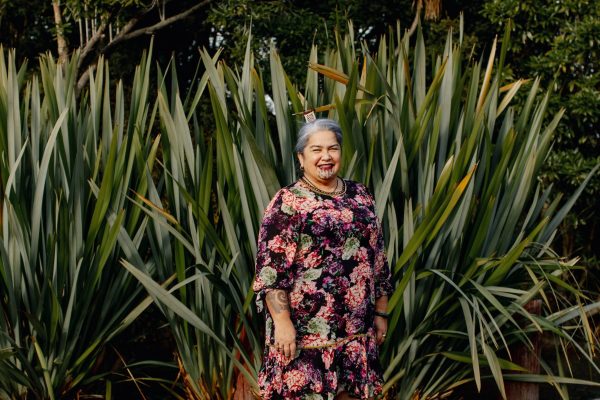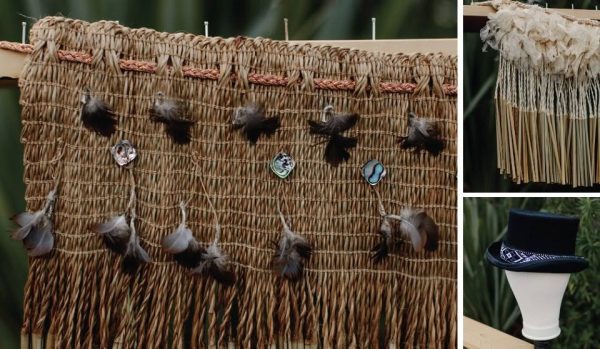Weaving Together Threads of Ancestry and Identity
For Te Roopu Raranga Whatu o Aotearoa chair Paula Rigby (Ngāi Tahu, Ngāti Kahungunu ki te Wairoa, Ngāi Tūhoe), leadership is fundamentally about respecting and empowering others and working together to nurture and preserve mātauranga Māori.

On a cold, damp day in Ōtautahi Christchurch, I am honoured to be meeting Paula Rigby, a skilled and highly experienced Māori weaver who currently chairs Te Roopu Raranga Whatu o Aotearoa (TRRWOA), the national collective of Māori weavers. In the city, she coordinates a local group called Ōtautahi Weavers and works as a pou whakahaere (cultural advisor) with Te Puni Kōkiri. Across town, Paula also has an active role at Rehua Marae on Springfield Road, St Albans, serving as board secretary at this inclusive multi-tribal and multicultural marae.
Paula tells me that her connection with Rehua Marae is through her father, who left Wairoa in the 1950s to learn a trade in Ōtautahi through the then seminal Māori Trade Training scheme. During that time, he stayed at the Rehua Māori Apprentices Hostel. ‘He met my mum here, so we grew up as urban Māori in Christchurch,’ says Paula. ‘We’d go to Wairoa every so often to visit my grandmother, who was a weaver. She used to enter her weaving in the Māori Women’s Welfare League competitions, and I remember her doing tāniko weaving – that was something I really wanted to learn. My great-grandmother was a weaver as well. Some of her pieces are in the Wairoa Museum and she was well known in the region for teaching people to weave.’
On her Pākehā side, Paula’s grandmother – a keen knitter and sewer – encouraged Paula’s creative spirit to flourish during her childhood. Toi Māori wasn’t really part of Paula’s life until she reached high school and began exploring her Māori identity. That’s when she took up kapa haka with a local Māori cultural group. A unique opportunity came along around the same time in the early 1980s when Ngā Hau e Whā National Marae was being built on Pages Road. A call went out for trainee carvers and weavers to get involved. ‘I put my hand up – that’s where it all started, learning to make tukutuku panels for the wharenui. From there, five of us were sent to Rotorua to the NZ Māori Arts and Crafts Institute, now Te Puia. That was where I learned tāniko weaving – and if you learn to do that, you can also weave the kākahu (Māori cloak) using the whatu aho rua or cloak weaving technique. I learned everything there.’
Paula’s academic journey started in 1992 at Christchurch Teachers College and today she is impressively well qualified across teaching, Māori Performing Arts and Māori Visual Arts.
‘I believe in whānau transformation through education. Monte Ohia [who was an influential Rātana minister and leader in Māori teaching and education] was a mentor for me in that space. I have a teaching degree and a diploma in teaching, but also wanted to learn more about things I love – so I have a Bachelor of Māori Performing Arts and a Bachelor of Māori Visual Arts. I have that more traditional grounding in Māori performing arts and visual arts, but I don’t see that as any different to Pākehā arts and learning about the great Western painters and sculptors of their times. Even the contemporary works I do are grounded in tradition; they bring forward those stories, those pūrākau into the contemporary context.’
Paula describes successful leadership not as some quality that she alone possesses, but as the fulfilment that comes through working to achieve collective goals.
She is currently studying for a Master of Māori and Indigenous Leadership at Te Whare Wānanga o Waitaha | University of Canterbury (UC). ‘I was looking for a challenge and I love the wānanga style there. I’m with a brilliant cohort – I’m enjoying their company and the way they think.’
Paula’s main project for her course is connected with her leadership in Māori weaving. A big goal and focus for her, tied into her role chairing TRRWOA, is to organise an indigenous arts symposium for all of the Pacific region in the not-too-distant future. ‘The last such symposium was held in 2010 so I think it’s time to have another one. Sharing indigenous knowledge is just so important. I know from my own personal experience that it can really strengthen and enrich your own practice. The idea is there would be opportunities for both academic sharing and practical workshops.’
Paula has been working to make a difference like this for decades. She started her professional career as a teacher and for many years was heavily involved with an annual primary schools’ cultural festival – showcasing not just kapa haka, but also Samoan, Korean and Filipino traditional dance.
When an opportunity came up – some 20 years ago now – to work for the Christchurch City Council as a Māori arts advisor, she did not hesitate to apply. ‘It seemed like a dream role to be employed to support something I feel passionate about. I decided to give it a go as I didn’t want to be looking back later thinking I should have gone for that role.’

It was much the same thinking that then motivated her to apply for the senior advisory role at Te Puni Kōkiri in 2018. ‘While this is not an arts dedicated role, I’m working with our people. As pou whakahaere, I provide cultural advice within our office and to government ministers. In addition, I still spend a lot of time working in the community and for community groups, connecting and supporting our people.’
Paula says the role of kairaranga (weaver) itself carries a huge amount of obligation to ensure that knowledge is passed down to future generations. She treads in the footsteps of revered Māori weavers, such as Rānui Ngārimu and the late Cath Brown. As Chair of TRRWOA, Paula is deeply devoted to furthering the national collective’s mission to nurture, develop and preserve the tikanga of raranga, whatu and tāniko (types of Māori weaving) in traditional and contemporary contexts. ‘We have a fairly strong membership but are currently focused on doing more in the regions and getting more young people involved. In 2025, we will be holding our next biennial Weavers National Hui – this is a crucial gathering and forum and a time for our senior practitioners to share their knowledge and leadership.’
There have been many highlights for Paula in her role with TRRWOA. ‘For example, I worked with the Christchurch Art Gallery and produced a beautiful exhibition in 2021 of our senior weavers, some of whom have passed away. It’s about honouring them and their legacies.’
That award-winning exhibition – Te Puna Waiora: Aligning the Threads of Kāhui Whiritoi – included incredible work by members of Kāhui Whiritoi, representing Aotearoa’s tohunga raranga (master weavers). It was the most significant showcase of Māori weaving to be displayed in Christchurch since the gallery hosted the homecoming of a major international touring exhibition early in 2007 (Toi Māori: The Eternal Thread – Te Aho Mutunga Kore).
Paula describes successful leadership not as some quality that she alone possesses, but as the fulfilment that comes through working to achieve collective goals. She quotes the following whakataukī: Ehara taku toa i te toa takitahi, engari he toa takitini – My success is not mine alone, but it is the strength of many. ‘When people believe in you, support you and uplift you, then they are all part of that equation. I don’t see success as a personal achievement – success is what we achieve as a rōpū (group).’

